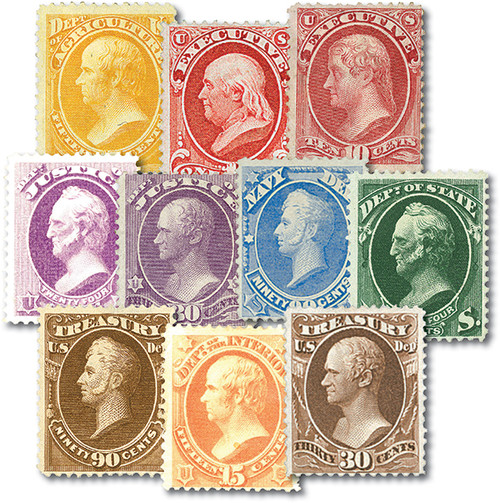
# 157//217 - 1873-88 Bank Note Stamp Collection, Set of 7 Stamps
Save on Classic U.S. Stamps – All over 130 Years Old
After the unpopularity of the 1869 Pictorial Series, the US postmaster general decided to issue new stamps. These were larger, better quality, and featured new, expertly engraved designs. They have come to be known today as the "Bank Note" stamps. This is because the series was printed by three different companies. The National Bank Note Company came first, then Continental, and finally American.
As the printing contract passed from company to company, so did the stamp dies and plates. However, each company added their own spin... They added secret marks to the plates, change dink colors, and even used different paper. These changes make collecting Bank Note stamps a fun challenge!
Spot the Differences in These 7 Bank Note Stamps
You'll love using your expert eye to identify the tiny details that make each stamp special:
US #157 – 2¢ Jackson, brown (Continental). Secret mark in the scroll lines above "U.S." at the top of the design. These lines are joined with a small diagonal line. When the secret mark isn't visible, this stamp must be identified by color (brown).
US #182 – 1¢ Franklin, dark ultramarine (American). Secret mark can be found in the pearl to the left of the numeral "I." Pearl has a small crescent in its bottom half. Printed on soft paper.
US #185 – 5¢ Taylor, blue (American). Printed on soft paper with new plates, therefore no secret marks were used.
US #189 – 15¢ Webster, red orange (American). Secret mark found in the lower part of the triangle in the upper left corner. Two lines were made thicker, forming a "V." Printed on soft paper.
US #205 – 5¢ Garfield, yellow brown (American). Replaced the Zachary Taylor with the recently assassinated President Garfield. Since this was a new printing plate, there are no secret marks. Printed on soft paper.
US #216 – 5¢ Garfield, indigo (American). From 1887 to 1888, the American Bank Note Company reissued earlier Bank Note stamps in new colors. US #205 was reissued in indigo, creating US #216.
US #217 – 30¢ Hamilton, orange brown (American). Part of the 1887-88 reissue. Since only the 1¢ to 15¢ denominations were given secret marks, US #217 has the same design as US #143 and #154.
Preserved by Caring Collectors for Over 130 Years
These fragile pieces of history have made a remarkable journey through time. Thanks to caring stamp collectors, they still exist today. Now it's your turn to preserve these American heirlooms by adding them to your collection.
Save on Classic U.S. Stamps – All over 130 Years Old
After the unpopularity of the 1869 Pictorial Series, the US postmaster general decided to issue new stamps. These were larger, better quality, and featured new, expertly engraved designs. They have come to be known today as the "Bank Note" stamps. This is because the series was printed by three different companies. The National Bank Note Company came first, then Continental, and finally American.
As the printing contract passed from company to company, so did the stamp dies and plates. However, each company added their own spin... They added secret marks to the plates, change dink colors, and even used different paper. These changes make collecting Bank Note stamps a fun challenge!
Spot the Differences in These 7 Bank Note Stamps
You'll love using your expert eye to identify the tiny details that make each stamp special:
US #157 – 2¢ Jackson, brown (Continental). Secret mark in the scroll lines above "U.S." at the top of the design. These lines are joined with a small diagonal line. When the secret mark isn't visible, this stamp must be identified by color (brown).
US #182 – 1¢ Franklin, dark ultramarine (American). Secret mark can be found in the pearl to the left of the numeral "I." Pearl has a small crescent in its bottom half. Printed on soft paper.
US #185 – 5¢ Taylor, blue (American). Printed on soft paper with new plates, therefore no secret marks were used.
US #189 – 15¢ Webster, red orange (American). Secret mark found in the lower part of the triangle in the upper left corner. Two lines were made thicker, forming a "V." Printed on soft paper.
US #205 – 5¢ Garfield, yellow brown (American). Replaced the Zachary Taylor with the recently assassinated President Garfield. Since this was a new printing plate, there are no secret marks. Printed on soft paper.
US #216 – 5¢ Garfield, indigo (American). From 1887 to 1888, the American Bank Note Company reissued earlier Bank Note stamps in new colors. US #205 was reissued in indigo, creating US #216.
US #217 – 30¢ Hamilton, orange brown (American). Part of the 1887-88 reissue. Since only the 1¢ to 15¢ denominations were given secret marks, US #217 has the same design as US #143 and #154.
Preserved by Caring Collectors for Over 130 Years
These fragile pieces of history have made a remarkable journey through time. Thanks to caring stamp collectors, they still exist today. Now it's your turn to preserve these American heirlooms by adding them to your collection.











